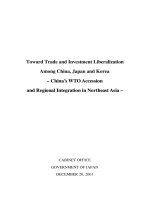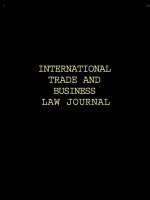Lecture International trade and investment (2/e): Chapter 15 - John Gionea
Bạn đang xem bản rút gọn của tài liệu. Xem và tải ngay bản đầy đủ của tài liệu tại đây (2 MB, 24 trang )
Chapter 15
Doing business in Emerging Markets
and Developing Economies (EMDEs)
Copyright 2006 McGraw-Hill Australia Pty Ltd. PPTs t/a International Trade and Investment:
An Asia-Pacific Perspective 2e by Gionea. Slides prepared by John Gionea..
15–1
Lecture plan
• Definition of Emerging Markets and
Developing Economies (EMDEs)
• Import markets in EMDEs
• Trade policy issues in EMDEs
• Export marketing aspects in EMDEs
• Considerations for investing in EMDEs
Copyright 2006 McGraw-Hill Australia Pty Ltd. PPTs t/a International Trade and Investment:
An Asia-Pacific Perspective 2e by Gionea. Slides prepared by John Gionea..
15–2
Definition of EMDEs
• In principle, the group of the emerging
market and developing economies
(EMDEs) includes all countries that are not
classified as advanced economies and
which are at a lower level of development
than the advanced economies.
Copyright 2006 McGraw-Hill Australia Pty Ltd. PPTs t/a International Trade and Investment:
An Asia-Pacific Perspective 2e by Gionea. Slides prepared by John Gionea..
15–3
General features of developing
countries
• High levels of rural population
• Relatively high population growth rates
• High proportion of population living in
absolute poverty
• Not well developed banking/credit facilities
Copyright 2006 McGraw-Hill Australia Pty Ltd. PPTs t/a International Trade and Investment:
An Asia-Pacific Perspective 2e by Gionea. Slides prepared by John Gionea..
15–4
General features of developing
countries cont.
• Relative lack of financial capital
(espec. FX)
• Relatively low level of infrastructure
(roads, telecommunications, education
institutions)
• Low marketing facilities
(e.g. storage, distribution)
Copyright 2006 McGraw-Hill Australia Pty Ltd. PPTs t/a International Trade and Investment:
An Asia-Pacific Perspective 2e by Gionea. Slides prepared by John Gionea..
15–5
Government sector in developing
countries
• Bigger size government sector than in ICs
(lower tax base)
• However, more government regulation
than in ICs
– big concern: control over the national
economy
• More development planning than in ICs, e.g.
– Indonesia: ‘Repellita’ (5-year plans)
• Malaysia,Taiwan
Copyright 2006 McGraw-Hill Australia Pty Ltd. PPTs t/a International Trade and Investment:
An Asia-Pacific Perspective 2e by Gionea. Slides prepared by John Gionea..
15–6
Trade and development
• Trade as engine of growth
• Import substitution vs export orientation
• Development strategies
– Stage 1: Exports of natural resources/
imports of manufactures
– Stage 2: Import substitution
– Stage 3: Export-led growth
Copyright 2006 McGraw-Hill Australia Pty Ltd. PPTs t/a International Trade and Investment:
An Asia-Pacific Perspective 2e by Gionea. Slides prepared by John Gionea..
15–7
The import market of EMDEs in 2003 (total
merchandise and services imports) by
main groupings (%); Total: US$2260b
Latin America
19%
Middle East
9%
Developing Asia
42%
Africa
9%
CIS C & E Europe
12%
9%
Source: adapted from WTO, International Trade Statistics 2004
Copyright 2006 McGraw-Hill Australia Pty Ltd. PPTs t/a International Trade and Investment:
An Asia-Pacific Perspective 2e by Gionea. Slides prepared by John Gionea..
15–8
Imports of EMDEs by regional
groupings by product, 2003, %
Source
Devel’g
Latin
Asia
America
Total
Farm
products
Minerals
Manufact
-ured
goods
C&E
Europe
Middle
East
Africa
100
100
100
100
100
9
10
10
12
16
17
12
11
6
11
73
75
78
79
71
Source: adapted from WTO, International Statistics 2004 and World Bank, World
Development Indicators 2004
Copyright 2006 McGraw-Hill Australia Pty Ltd. PPTs t/a International Trade and Investment:
An Asia-Pacific Perspective 2e by Gionea. Slides prepared by John Gionea..
15–9
The share of China and Eastern Europe*
in world merchandise imports,
1948–2000
% of World Imports
12
10
8
6
China
E.Europe
4
2
0
1948 1953 1963 1973 1983 1993 2000
* Eastern Europe = Former Soviet Union and C. & E. Europe
Copyright 2006 McGraw-Hill Australia Pty Ltd. PPTs t/a International Trade and Investment:
An Asia-Pacific Perspective 2e by Gionea. Slides prepared by John Gionea..
15–10
China’s share of world merchandise
imports, by product, 1990, 2000, %
8
7
6
5
4
%
3
2
1
0
Farm
products
Energy
Iron and
Chemicals Machinery Textiles
steel
1990
1.8
1.4
2.5
2.2
1.8
4.9
2000
2.4
2.2
5.4
4.4
2.9
7.1
Copyright 2006 McGraw-Hill Australia Pty Ltd. PPTs t/a International Trade and Investment:
An Asia-Pacific Perspective 2e by Gionea. Slides prepared by John Gionea..
15–11
Trade policy issues
Tariffs
• Generally higher than in ICs.
• Lower proportion of tariffs are bound.
• Regional economic groupings (e.g. AFTA,
MERCOSUR) discriminate against nonmembers.
(See impact of AFTA’s intra-regional tariff
cuts on next slide.)
Copyright 2006 McGraw-Hill Australia Pty Ltd. PPTs t/a International Trade and Investment:
An Asia-Pacific Perspective 2e by Gionea. Slides prepared by John Gionea..
15–12
Comparison of 1999 MFN simple tariff
rates and average CEPT rates in selected
AFTA countries 1999, 2003
Country
Indonesia
Malaysia
Philippines
Singapore
Thailand
Vietnam
MFN
1999
10.9
7.1
10.0
0.0
21.6
15.1
Intra-AFTA (%)
1999
2003
5.85
3.71
3.17
2.06
7.00
3.75
0.0
0.0
9.75
4.64
3.78
2.02
Source: adapted from World Bank Development Indicators, 2004, table 6.6 and
ASEAN Secretariat website <www.us-asean.org/afta.htm>
Copyright 2006 McGraw-Hill Australia Pty Ltd. PPTs t/a International Trade and Investment:
An Asia-Pacific Perspective 2e by Gionea. Slides prepared by John Gionea..
15–13
Trade policy issues
• Non-tariff measures
– South Korea : ‘Pigs is pigs!’
– Malaysia: import licences
(plastics raw materials)
• Barriers to trade in services
Copyright 2006 McGraw-Hill Australia Pty Ltd. PPTs t/a International Trade and Investment:
An Asia-Pacific Perspective 2e by Gionea. Slides prepared by John Gionea..
15–14
Export marketing issues
• Cultural differences
– language
– cultural restrictions on
consumption/imports
• Price strategies
– differentiated prices (on low side)
– ‘price markets’
Copyright 2006 McGraw-Hill Australia Pty Ltd. PPTs t/a International Trade and Investment:
An Asia-Pacific Perspective 2e by Gionea. Slides prepared by John Gionea..
15–15
Export marketing issues cont.
• Distribution
– longer distribution channels than in ICs
• Promotion
– Less spending required compared to ICs
– However, growing promotion expenditure
in Asia and Latin America
(See Table 15.10 in textbook for data on
advertising expenditure.)
Copyright 2006 McGraw-Hill Australia Pty Ltd. PPTs t/a International Trade and Investment:
An Asia-Pacific Perspective 2e by Gionea. Slides prepared by John Gionea..
15–16
Leading EMDEs in developing Asia in terms of
trend growth in advertising expenditure, 1998–
2003
% p.a
Indonesia
34.6
17.9
China
Thailand
14.0
Malaysia
11.0
India
8.8
4.0
Philippines
Sri Lanka
2.1
Source: adapted from Euromonitor, GMID, 2004
Copyright 2006 McGraw-Hill Australia Pty Ltd. PPTs t/a International Trade and Investment:
An Asia-Pacific Perspective 2e by Gionea. Slides prepared by John Gionea..
15–17
Australia’s position in the import
markets of transition economies
• Best position in China: A$6.5 billion in 2000–2001;
2% of China’s imports; 8th rank
• Small exports to other markets: the share of
Australian exports varies between 0.1% and 0.7%
(Romania)
• Exports include primary products, but also some
elaborately transformed manufactures (e.g.
telecom equipment, measuring and controlling
instruments, medicinal and pharmaceutical goods
Copyright 2006 McGraw-Hill Australia Pty Ltd. PPTs t/a International Trade and Investment:
An Asia-Pacific Perspective 2e by Gionea. Slides prepared by John Gionea..
15–18
Transition economies
• Current and former centrally planned economies in
transition to a market-based economy
– former Soviet Union countries; C. & E. Europe;
PR China and Vietnam
• China – the world's 3rd largest economy
(PPP method)
• Government sector – still the leading sector in FSU;
however, in 2001 it accounted for less than 50% in
most C. & E. European countries
• Privatisation of state enterprises
Copyright 2006 McGraw-Hill Australia Pty Ltd. PPTs t/a International Trade and Investment:
An Asia-Pacific Perspective 2e by Gionea. Slides prepared by John Gionea..
15–19
Trade issues in transition
economies
• Decentralisation of foreign trade
(China since 1985)
• From central plan to tariff protection
• Members of WTO: Czech Republic, Hungary,
Poland, Slovak Rep., Romania, China (November,
2001)
• 8 countries joined the EU in 2004 with 3 more to
follow (Bulgaria, Romania and Croatia)
• Abolition of import licences/quotas
• Over 1992–2001, China has undertaken a
number of 8 reductions of non-tariff measures
Copyright 2006 McGraw-Hill Australia Pty Ltd. PPTs t/a International Trade and Investment:
An Asia-Pacific Perspective 2e by Gionea. Slides prepared by John Gionea..
15–20
FDI inflows into EMDEs by main
geographic grouping, 1993–2003, US$b
120
100
80
US$Billion
Developing Asia
60
C&E Europe
Middle East
Africa
40
Latin America
20
0
1993 1994 1995 1996 1997 1998 1999 2000 2001 2002 2003
-20
Source: adapted from UNCTAD, World Investment Report, 2004
Copyright 2006 McGraw-Hill Australia Pty Ltd. PPTs t/a International Trade and Investment:
An Asia-Pacific Perspective 2e by Gionea. Slides prepared by John Gionea..
15–21
Trends and issues in direct
investment in EMDEs
• Developing Asia – the largest beneficiary of
inward FDI among EMDEs. ( US$68b in
2003). China: top destination 2001–2003.
• FDI in the service sector growing fast, but
manufacturing still takes about 55% of inward
FDI.
• Political stability: key consideration for FDI
• Government controls
• Government attitude to FDI
(the ‘obsolescing bargain’)
• Joint venture – preferred form of FDI?
Copyright 2006 McGraw-Hill Australia Pty Ltd. PPTs t/a International Trade and Investment:
An Asia-Pacific Perspective 2e by Gionea. Slides prepared by John Gionea..
15–22
Trends and issues in direct
investment in EMDEs cont.
• Government controls
• Ease to do business
– best performers: Lithuania (ranked
17th), Slovakia (18th), Botswana(19th),
and Thailand (20th)
• Copyright issues (e.g. China)
• Transfer pricing
• Incentives
• Personnel
Copyright 2006 McGraw-Hill Australia Pty Ltd. PPTs t/a International Trade and Investment:
An Asia-Pacific Perspective 2e by Gionea. Slides prepared by John Gionea..
15–23
Sectoral trends in FDI inward stock
in transition economies, 1999
• Leading sector: tertiary (US$49.3b,
50.1% of total)
– finance; trade; transport, storage and
communications
• Secondary sector: US$43.5b (43.5%)
– food, beverages; motor vehicles and
other transport equipment; machinery
and equipment
• Primary: US$2.4b (2.5%)
Copyright 2006 McGraw-Hill Australia Pty Ltd. PPTs t/a International Trade and Investment:
An Asia-Pacific Perspective 2e by Gionea. Slides prepared by John Gionea..
15–24









